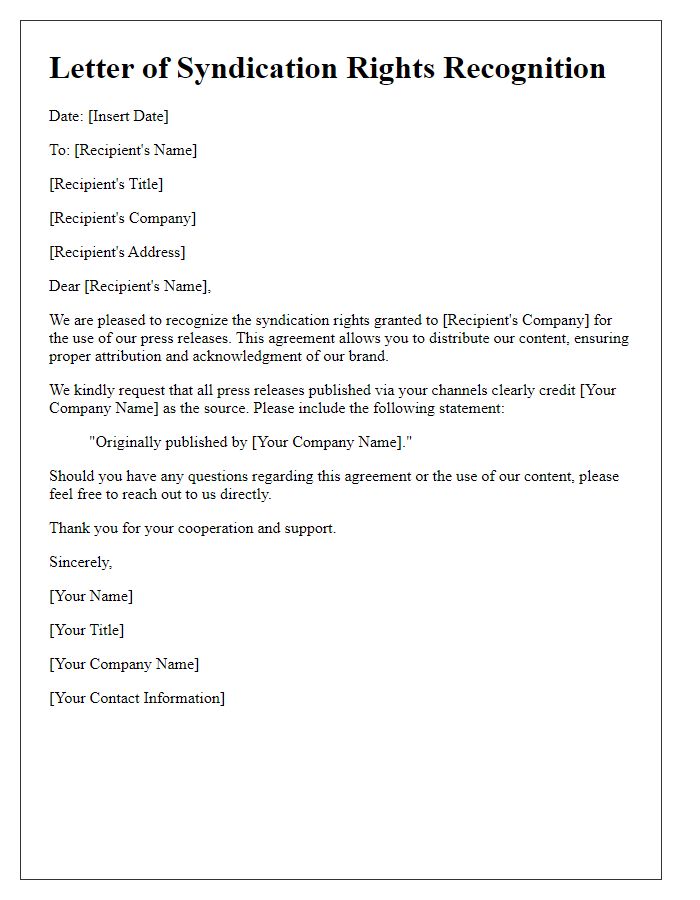Are you looking to clarify the syndication rights for your latest work? Understanding these rights is crucial for both creators and publishers, as they determine how and where your content can be shared. In this article, we'll break down the essential components of the letter template you'll need to confirm syndication rights effectively. So, let's dive in and explore how you can protect your work with confidence!

Syndication terms and conditions
Syndication rights allow content creators to distribute their work across various platforms while retaining original ownership. These rights, outlined in specific syndication agreements, detail the terms and conditions under which content can be shared, including duration (often ranging from one year to multiple years), territorial restrictions (specific countries or regions where the content can be published), and media types (such as print, online, or broadcast). Additionally, compensation models may vary, involving flat fees, royalties based on viewership, or a combination thereof. Important aspects also include attribution requirements, which dictate how authorship must be credited in distributed works. Understanding these elements is crucial for both creators and syndicators to ensure respectful and profitable collaborations.
Names and roles of involved parties
Syndication rights confirmation involves several key parties, including the Content Owner (typically the writer or publisher) who holds the original rights to the material, the Syndicator (a company or individual responsible for distributing the content), and the Licensee (the entity that wishes to use or distribute the content). For example, if "John Doe" operates as a Content Owner, and "Syndicate Co." acts as the Syndicator, the Licensee might be "Local Newspaper Inc." seeking permission to publish the content. Each party's roles must be clearly outlined, including descriptions of associated rights, duration of the agreement, and any financial considerations such as royalties or fees involved in the syndication process. This clarity ensures all parties understand their responsibilities and entitlements, reducing the risk of potential disputes over the use of the content across various platforms.
Duration of syndication rights
Syndication rights for media content typically span a specified duration defined in contracts. These rights grant distribution entities permission to broadcast or publish content across various platforms. Common durations range from one year to multiple years, depending on agreements established between content creators and distributors. Specific terms, including renewal options or territory limitations, directly influence these durations. Adhering to these terms ensures legal compliance while maximizing content reach and audience engagement across diverse media outlets.
Content distribution scope
Content distribution scope defines the parameters within which intellectual property rights (such as authorship and distribution agreements) are allocated. In the context of media, the scope includes territory (like North America, Europe, or Asia), duration (specific time frames such as one year or perpetual rights), and platforms (such as digital outlets, print media, or broadcast channels). Understanding these terms is crucial for content creators and distributors to ensure proper usage and monetization of their works. The clarity in distribution rights determines compensation outcomes, audience reach, and the potential for future collaborations in industries such as publishing, film, and online content platforms.
Contact information and signatures
Syndication rights for content distribution allow media outlets to publish or broadcast works while respecting intellectual property laws. Important metrics include potential reach (such as readership numbers or audience size), duration (timeframe for which rights are granted), and exclusivity terms (whether rights are non-exclusive or exclusive). In confirming syndication rights, essential elements include contact information for both parties (name, address, email, phone number) and signatures, ensuring clear agreement on the terms and conditions of syndication. Such agreements often involve specific content types, including articles, images, or videos, and may apply to various platforms like newspapers, magazines, and online publications. Clarity in this agreement protects the rights of creators while enabling broader distribution and audience engagement.
Letter Template For Confirming Syndication Rights. Samples
Letter template of syndication rights acknowledgment for publication agreements.

Letter template of syndication rights validation for content distribution.

Letter template of syndication rights approval for broadcasting purposes.

Letter template of syndication rights notification for collaborative projects.

Letter template of syndication rights verification for online platforms.









Comments